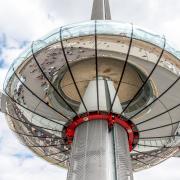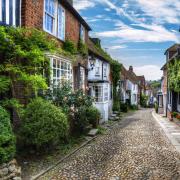Originally a Saxon fishing village called Meeching, it was developed during the Middle Ages when the nearby port of Seaford began to silt up. The ferry service to Dieppe is still the lifeblood of the town where Lord Lucan was last seen and where Vietnam’s founder Ho Chi Minh worked as a pastry chef.

HARBOUR ARM
The Harbour Arm at Newhaven extends out 700m from the West Beach. It has been here since 1890 and, considering the battering it takes every winter from the English Channel, it’s amazing that it still stands strong.

HO CHI MINH MEMORIAL
As unlikely as it sounds, Ho Chi Minh, the founder of modern Vietnam, has links to this Sussex town. In the years following the end of World War One, he worked on the Newhaven to Dieppe ferry as a pastry chef.

CORMORANT
The Cormorant at the river mouth of the port was made by local sculptor Christian Funnell in 2008. It sits on the remains of the old bridge. The seabird is depicted with its wings spread, something they do to dry their plumage.

FORMER NATIONAL WESTMINSTER BANK
The former National Westminster Bank building at the bottom of the High Street, dating from around 1900, is a gorgeous building. It reflects the time when, in revenue terms, Newhaven was the sixth largest port in the whole country.

THE BRIDGE HOTEL
The Bridge Hotel at the bottom of the High Street was built at some time in the 1700s as a Georgian residence. After St Michael’s Church, it’s probably the oldest building in the town. It became famous after March 3rd 1848, when the deposed Louis Philippe I, the last King of France, landed at Newhaven with his Queen, Maria Amalia. They stayed overnight at what was then called The Bridge Inn before heading to London after narrowly escaping France with their lives.

DENTON ROAD
Denton still sees itself as a village. The Manor of Denton once belonged to Harold Godwin, the father of King Harold II, the last-crowned Anglo-Saxon King of England. He’s the one that was killed at the Battle of Hastings. These beautiful Sussex-flint fronted houses are on Denton Road.

VICTORIAN LETTERBOX
A relatively rare Queen Victoria letterbox in Ship Street. Probably fewer than 10% of the country’s letterboxes date from this time. It’s identifiable by the letters VR.

CAT WALL
The self-styled famous cat wall of Newhaven in Ship Street.

LORD LUCAN
The story of Lord Lucan, the murder of his childrens’ nanny Sandra Rivett, the attempted murder of his wife Veronica and ultimately his disappearance, is one that has intrigued the nation ever since the whole drama unfolded in November 1974. Norman Road is where the trail went cold, as this was where his Ford Corsair car was found. It was the last trace of the man.

BANDSTAND
Erected on Denton Island in 2019, the quirky Bandstand is home to various summer music events.

LOCAL RESIDENT CATHERINE GENNARO
'Newhaven is very eclectic. It looks slightly worn and uncared-for but there’s a huge mix of different types of people here. It has rakish Brighton on one side and rather posh Eastbourne on the other - and then you’ve got Lewes, which is quite intellectual. There’s a tendency for people to ignore it because of the vile traffic system. They tend to go round which is a shame because it has an interesting history. It just doesn’t get any lifeblood into the centre so it feels neglected. They should never have done what they did with the road [create a one-way system designed to divert traffic away]. It turned the High Street into an island.’



























